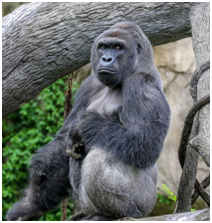The tragic death of Harimbe, the gorilla at the Cincinnati Zoo, became an occasion for conflict as people lined up to defend and vilify both the zookeepers who shot the animal and the mother whose child fell into the enclosure. Fortunately, there are also some, like Jane Goodall, who have practiced Cooperative Wisdom in the face of this tragic event. In an interview with Azzedine Downes, Goodall uses her extensive expertise to do a nuanced analysis of what went wrong and what could be done differently in the future.
For those who practice Cooperative Wisdom, every episode of harm is an opportunity to evaluate the shortcomings in our cooperative systems. A zoological garden is, of course, a highly specialized environment. In every specialized setting, experts establish goals and determine measures of satisfactory performance. For a zoo, the essential goals for exhibit design are very clear: (1) allow visitors to see and be educated about exhibited animals, (2) ensure the comfort and health of the exhibited animals, and (3) guarantee safety for both visitors and exhibited animals.
Everyone understands that humans often fall short of their goals. For a zoo, however, failure to meet these goals—especially the third one—can be catastrophic. That’s why zookeepers must practice proactive compassion—anticipating harms and doing everything in their power to prevent them. If, despite those efforts, harm occurs, good cooperative partners will move beyond blame to engage in honest evaluation of what happened, why it happened and what can be done to prevent such harms in the future.
This kind of analysis is necessary because, if we are to thrive in cooperative settings, we must avoid unnecessary risk in pursuing our goals. Parents do this all the time, constantly assessing what kinds of risks are reasonable for a particular child. One child can be trusted to stay on the right side of a barricade; another cannot. Uninvolved bystanders can also practice proactive compassion. In the case of the Cincinnati Zoo, it’s impossible not to wonder whether someone noticed a small child making his way past the safety railing. What if that person had called to the child or reached in to take his hand?
Experts who know the environment best have a particular obligation to anticipate harms on behalf of the larger community. In this case, as Goodall points out, exhibit designers and animal care providers at the Cincinnati Zoo and at other zoological parks must work together to analyze this tragedy and learn what they can about how to improve safeguards in zoo environments. Accrediting associations of zoos have an opportunity to respond pro-actively to the incident at the Cincinnati Zoo. What variety of gorilla exhibit designs have been accredited? What strengths and weakness do they have? What standards could improve the ability of zoos to meet their three essential goals in relation to gorillas and other large animals?
Rather than looking for people to blame, Cooperative Wisdom pushes us to acknowledge that no one—parent, zookeepers, bystanders or the child himself—intended for this harm to occur. Like Jane Goodall, we must be concerned about everyone who has been impacted by this tragedy. And then we must take up the difficult work of revising our practices so that such an event does not occur again.


Leave a Reply